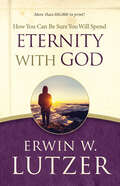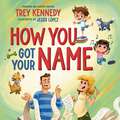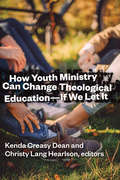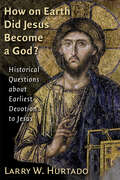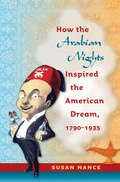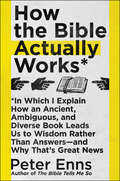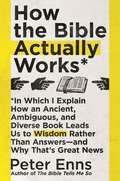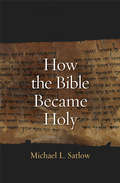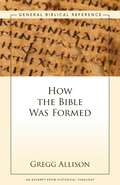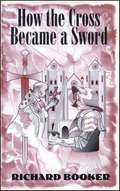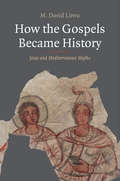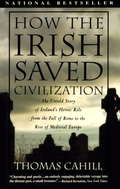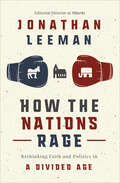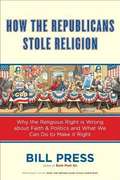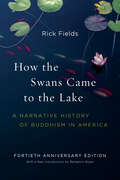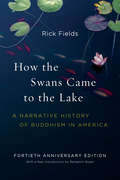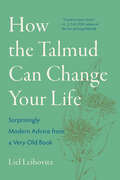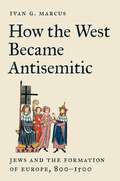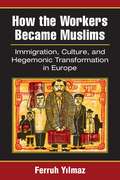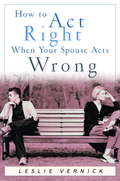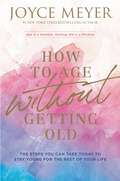- Table View
- List View
How You Can Be Sure You Will Spend Eternity with God
by Erwin W. Lutzer"Be wrong about social security, be wrong about baseball, be wrong about your career choice, but don&’t be wrong about where you will spend eternity."How You Can Be Sure You Will Spend Eternity with God—it&’s a big promise, but this short book delivers. It answers a host of questions, such as:Will good deeds help me get into heaven?Who goes to heaven and who doesn&’t?What role do I have in my own salvation?Can I lose my salvation if I commit a serious sin?Is it wrong to doubt my salvation, and what should I do if I doubt? Dr. Lutzer takes many scriptural teachings and siphons them into clear, cohesive truths. The result is a concise, accessible book about how to be saved and be sure you are saved. It is straight gospel—applicable to the skeptic, newly saved, and long-time believer alike.
How You Can Be Sure You Will Spend Eternity with God
by Erwin W. Lutzer"Be wrong about social security, be wrong about baseball, be wrong about your career choice, but don&’t be wrong about where you will spend eternity."How You Can Be Sure You Will Spend Eternity with God—it&’s a big promise, but this short book delivers. It answers a host of questions, such as:Will good deeds help me get into heaven?Who goes to heaven and who doesn&’t?What role do I have in my own salvation?Can I lose my salvation if I commit a serious sin?Is it wrong to doubt my salvation, and what should I do if I doubt? Dr. Lutzer takes many scriptural teachings and siphons them into clear, cohesive truths. The result is a concise, accessible book about how to be saved and be sure you are saved. It is straight gospel—applicable to the skeptic, newly saved, and long-time believer alike.
How You Got Your Name
by Trey KennedyFrom comedian and viral content sensation Trey Kennedy comes How You Got Your Name, a hilarious and touching book celebrating the wild journey to each child's name and the meaningful story behind it.When one little guy asks his parents about how they chose his name, he's in for a wild ride! Readers will giggle at the silly names the parents in the story almost picked as they're inspired by everything around them, including playground equipment, the foods in the grocery store, and cell phone sounds. The funny and sweet story ends with a beautiful reminder for kids that God knows their name too.With vibrant illustrations, this jacketed picture bookis for boys and girls, ages 4 to 8;gives readers a chance to guess the character's name, making each reading experience memorable and laugh-out-loud funny;includes space for parents to fill out the real story behind their child's name, making this book a wonderful keepsake for the whole family; andis a perfect gift for baby showers and birthdays and for showing your child just how much thought and love went into their name.With its lighthearted tone and prompts for readers to share silly name ideas, How You Got Your Name is a delightful read for families to enjoy together.
How Youth Ministry Can Change Theological Education -- If We Let It
by Kenda Creasy Dean Christy Lang HearlsonSince 1993, forty-nine theological seminaries have created opportunities for high school students to participate in on-campus High School Theology Programs (HSTPs) that invite them to engage in serious biblical and theological study. Many of the young people who take part in these programs go on to become pastoral or lay leaders in their churches. What has made these programs so successful — especially given the well-documented “crisis of faith” among young people today? In this book thirteen contributors — many of whom have created or led one of these innovative theology programs — investigate answers to this question. They examine the pedagogical practices the HSTPs have in common and explore how they are contributing to the leadership of the church. They then show how the lessons gleaned from these successful programs can help churches, denominations, and seminaries reimagine both theological education and youth ministry.
How Youth Ministry Can Change Theological Education -- If We Let It
by Kenda Creasy DeanSince 1993, forty-nine theological seminaries have created opportunities for high school students to participate in on-campus High School Theology Programs (HSTPs) that invite them to engage in serious biblical and theological study. Many of the young people who take part in these programs go on to become pastoral or lay leaders in their churches. What has made these programs so successful — especially given the well-documented &“crisis of faith&” among young people today? In this book thirteen contributors — many of whom have created or led one of these innovative theology programs — investigate answers to this question. They examine the pedagogical practices the HSTPs have in common and explore how they are contributing to the leadership of the church. They then show how the lessons gleaned from these successful programs can help churches, denominations, and seminaries reimagine both theological education and youth ministry.
How on Earth Did Jesus Become a God?: Historical Questions about Earliest Devotion to Jesus
by Larry W. HurtadoIn How on Earth Did Jesus Become a God? Larry Hurtado investigates the intense devotion to Jesus that emerged with surprising speed after his death. Reverence for Jesus among early Christians, notes Hurtado, included both grand claims about Jesus' significance and a pattern of devotional practices that effectively treated him as divine. This book argues that whatever one makes of such devotion to Jesus, the subject deserves serious historical consideration. Mapping out the lively current debate about Jesus, Hurtado explains the evidence, issues, and positions at stake. He goes on to treat the opposition to -- and severe costs of -- worshiping Jesus, the history of incorporating such devotion into Jewish monotheism, and the role of religious experience in Christianity's development out of Judaism. The follow-up to Hurtado's award-winningLord Jesus Christ (2003), this book provides compelling answers to queries about the development of the church's belief in the divinity of Jesus.
How the Arabian Nights Inspired the American Dream, 1790-1935
by Susan NanceAmericans have always shown a fascination with the people, customs, and legends of the "East"--witness the popularity of the stories of theArabian Nights, the performances of Arab belly dancers and acrobats, the feats of turban-wearing vaudeville magicians, and even the antics of fez-topped Shriners. In this captivating volume, Susan Nance provides a social and cultural history of this highly popular genre of Easternized performance in America up to the Great Depression. According to Nance, these traditions reveal how a broad spectrum of Americans, including recent immigrants and impersonators, behaved as producers and consumers in a rapidly developing capitalist economy. In admiration of theArabian Nights, people creatively reenacted Eastern life, but these performances were also demonstrations of Americans' own identities, Nance argues. The story of Aladdin, made suddenly rich by rubbing an old lamp, stood as a particularly apt metaphor for how consumer capitalism might benefit each person. The leisure, abundance, and contentment that many imagined were typical of Eastern life were the same characteristics used to define "the American dream. " The recent success of Disney'sAladdinmovies suggests that many Americans still welcome an interpretation of the East as a site of incredible riches, romance, and happy endings. This abundantly illustrated account is the first by a historian to explain why and how so many Americans sought out such cultural engagement with the Eastern world long before geopolitical concerns became paramount.
How the Bible Actually Works: In Which I Explain How An Ancient, Ambiguous, and Diverse Book Leads Us to Wisdom Rather Than Answers -- and Why That's Great News (G - Reference, Information and Interdisciplinary Subjects)
by Peter EnnsControversial evangelical Bible scholar, popular blogger and podcast host of The Bible for Normal People, and author of The Bible Tells Me So and The Sin of Certainty explains that the Bible is not an instruction manual or rule book but a powerful learning tool that nurtures our spiritual growth by refusing to provide us with easy answers but instead forces us to acquire wisdom. For many Christians, the Bible is a how-to manual filled with literal truths about belief that must be strictly followed. But the Bible is not static, Peter Enns argues. It does not hold easy answers to the perplexing questions and issues that confront us in our daily lives. Rather, the Bible is a dynamic instrument for study that not only offers an abundance of insights but provokes us to find our own answers to spiritual questions, cultivating God’s wisdom within us. <P><P>“The Bible becomes a confusing mess when we expect it to function as a rulebook for faith. But when we allow the Bible to determine our expectations, we see that Wisdom, not answers, is the Bible’s true subject matter,” writes Enns. This distinction, he points out, is important because when we come to the Bible expecting it to be a textbook intended by God to give us unwavering certainty about our faith, we are actually creating problems for ourselves. The Bible, in other words, really isn’t the problem; having the wrong expectation is what interferes with our reading.Rather than considering the Bible as an ancient book weighed down with problems, flaws, and contradictions that must be defended by modern readers, Enns offers a vision of the holy scriptures as an inspired and empowering resource to help us better understand how to live as a person of faith today. How the Bible Actually Works makes clear that there is no one right way to read the Bible. Moving us beyond the damaging idea that “being right” is the most important measure of faith, Enns’s freeing approach to Bible study helps us to instead focus on pursuing enlightenment and building our relationship with God—which is exactly what the Bible was designed to do.
How the Bible Actually Works: In which I Explain how an Ancient, Ambiguous, and Diverse Book Leads us to Wisdom rather than Answers - and why that's Great News
by Peter Enns'Seldom will you encounter such a fine combination of historical scholarship, interesting reading, and clever humour in one Biblical study. And then filled with faith and hope besides! Peter Enns does it again!' Richard Rohr, author of Falling UpwardFor many Christians, the Bible is a how-to manual filled with literal truths about belief that must be strictly followed. But the Bible is not an instruction manual or rule book but a powerful learning tool that nurtures our spiritual growth, argues Bible scholar Peter Enns. It does not hold easy answers to the perplexing questions and issues that confront us in our daily lives. Rather, the Bible is a dynamic instrument for study that not only offers an abundance of insights but provokes us to find our own answers to spiritual questions, cultivating God's wisdom within us.'The Bible becomes a confusing mess when we expect it to function as a rulebook for faith. But when we allow the Bible to determine our expectations, we see that Wisdom, not answers, is the Bible's true subject matter', writes Enns. This distinction, he points out, is important because when we come to the Bible expecting it to be a textbook intended by God to give us unwavering certainty about our faith, we are actually creating problems for ourselves. The Bible, in other words, really isn't the problem; having the wrong expectation is what interferes with our reading.Rather than considering the Bible as an ancient book weighed down with problems, flaws, and contradictions that must be defended by modern readers, Enns offers a vision of the holy scriptures as an inspired and empowering resource to help us better understand how to live as a person of faith today.How the Bible Actually Works makes clear that there is no one right way to read the Bible. Moving us beyond the damaging idea that 'being right' is the most important measure of faith, Enns's freeing approach to Bible study helps us to instead focus on pursuing enlightenment and building our relationship with God - which is exactly what the Bible was designed to do.
How the Bible Became Holy
by Michael L SatlowBeginning with Walt Whitman singing hymns at a wounded soldier's bedside during the Civil War, this surprising and vivid anthology ranges straight through to the twenty-first century to end with Francine Prose crying tears of complicated joy at the sight of Whitman's words in Zuccotti Park during the brief days of the Occupy movement. The first anthology of its kind, Radiant Truths gathers an exquisite selection of writings by both well-known and forgotten American authors and thinkers, each engaged in the challenges of writing about religion, of documenting "things unseen." Their contributions to the genre of literary journalism-the telling of factual stories using the techniques of fiction and poetry-make this volume one of the most exciting anthologies of creative nonfiction to have emerged in years. Jeff Sharlet presents an evocative selection of writings that illuminate the evolution of the American genre of documentary prose. Each entry may be savored separately, but together the works enrich one another, engaging in an implicit and continuing conversation that reaches across time and generations.Including works by: Walt Whitman Henry David Thoreau Mark Twain Meridel Le Sueur Zora Neale Hurston Mary McCarthy James Baldwin Norman Mailer Ellen Willis Anne Fadiman John Jeremiah Sullivan Francine Prose Garry Wills and many others
How the Bible Was Formed: A Zondervan Digital Short
by Gregg AllisonDerived from Gregg Allison’s magisterial Historical Theology, this digital short provides a concise but thorough history of how both New Testament and Old Testament books were identified as Scripture and incorporated into the final canon. Attention is paid to differences between the Catholic and Protestant canons and to debates about the inclusion of apocryphal books. The equivalent of a series of lectures on Scripture’s formation, with extensive footnoting for further reading, this digital short provides a one-stop reference resource on a foundational matter of Christian doctrine and worship.
How the Cross Became a Sword
by Richard BookerThis publication explains the events that separated Christianity from its Jewish roots and established anti-Semitism as official church doctrine.
How the Gospels Became History: Jesus and Mediterranean Myths (Synkrisis)
by M. David LitwaA compelling comparison of the gospels and Greco-Roman mythology which shows that the gospels were not perceived as myths, but as historical records Did the early Christians believe their myths? Like most ancient—and modern—people, early Christians made efforts to present their myths in the most believable ways. In this eye-opening work, M. David Litwa explores how and why what later became the four canonical gospels take on a historical cast that remains vitally important for many Christians today. Offering an in-depth comparison with other Greco-Roman stories that have been shaped to seem like history, Litwa shows how the evangelists responded to the pressures of Greco-Roman literary culture by using well-known historiographical tropes such as the mention of famous rulers and kings, geographical notices, the introduction of eyewitnesses, vivid presentation, alternative reports, and so on. In this way, the evangelists deliberately shaped myths about Jesus into historical discourse to maximize their believability for ancient audiences.
How the Heart Runs (Mystery and the Minister’s Wife Series, Book 18)
by Anne Marie RodgersThe woman, clearly shaken, pleads for Kate to stay by her side even as paramedics come to her aid, and they quickly forge a friendship. Despite Kate's growing affection for Emmaline, the woman seems evasive about the details of her sickness--and her past--and Kate begins to question what exactly has afflicted Emmaline. How can Kate properly minister to her if she doesn't know the whole truth? Who is this private, lonely woman? Meanwhile, a young mother in town is slowly recovering from major surgery and her family struggles to cope. As Kate cares for the family while also meeting the demands of her friendship with Emmaline, she begins to see there's much more to the mysterious woman than she ever imagined.
How the Irish Saved Civilization (The Hinges of History)
by Thomas CahillNATIONAL BESTSELLER • A book in the best tradition of popular history—the untold story of Ireland's role in maintaining Western culture while the Dark Ages settled on Europe. • The perfect St. Patrick's Day gift!Every year millions of Americans celebrate St. Patrick's Day, but they may not be aware of how great an influence St. Patrick was on the subsequent history of civilization. Not only did he bring Christianity to Ireland, he instilled a sense of literacy and learning that would create the conditions that allowed Ireland to become "the isle of saints and scholars"—and thus preserve Western culture while Europe was being overrun by barbarians. In this entertaining and compelling narrative, Thomas Cahill tells the story of how Europe evolved from the classical age of Rome to the medieval era. Without Ireland, the transition could not have taken place. Not only did Irish monks and scribes maintain the very record of Western civilization -- copying manuscripts of Greek and Latin writers, both pagan and Christian, while libraries and learning on the continent were forever lost—they brought their uniquely Irish world-view to the task. As Cahill delightfully illustrates, so much of the liveliness we associate with medieval culture has its roots in Ireland. When the seeds of culture were replanted on the European continent, it was from Ireland that they were germinated. In the tradition of Barbara Tuchman's A Distant Mirror, How The Irish Saved Civilization reconstructs an era that few know about but which is central to understanding our past and our cultural heritage. But it conveys its knowledge with a winking wit that aptly captures the sensibility of the unsung Irish who relaunched civilization.
How the Nations Rage: Rethinking Faith and Politics in a Divided Age
by Jonathan LeemanHow can the church move forward in unity amid such political strife and cultural contention?As Christians, we&’ve felt pushed to the outskirts of national public life, yet even within our congregations we are divided about how to respond. Some want to strengthen the evangelical voting bloc. Others focus on social justice causes, and still others would abandon the public square altogether. What do we do when brothers and sisters in Christ sit next to each other in the pews but feel divided and angry? Is there a way forward?In How the Nations Rage, political theology scholar and pastor Jonathan Leeman challenges Christians from across the spectrum to hit the restart button byshifting our focus from redeeming the nation to living as a nation already redeemedrejecting the false allure of building heaven on earth while living faithfully as citizens of a heavenly kingdomletting Jesus&’ teaching shape our public engagement as we love our neighbors and seek justiceWhen we identify with Christ more than a political party or social grouping, we can return to the church&’s unchanging political task: to become the salt and light Jesus calls us to be and offer the hope of his kingdom to the nations.
How the Republicans Stole Religion: Why the Religious Right is Wrong about Faith & Politics and What We Can Do to Make it Right
by Bill PressFor decades, Press argues, conservatives have defined religion so narrowly that Democrats and liberals have been pushed outside the fold. According to their narrow gospel, God put George W. Bush in the White House to deal with gays, guns, and abortion—and those who don’t agree are on the sure road to hell. How the Republicans Stole Religion is Press’s fervent call for the left to reclaim religion and return it to its basic principles of social justice, charity, and tolerance.
How the Swans Came to the Lake: A Narrative History of Buddhism in America
by Rick Fields Benjamin BoginThis new updated edition of How the Swans Came to the Lake includes much new information about recent events in Buddhist groups in America and discusses such issues as spiritual authority, the role of women, and social action.
How the Swans Came to the Lake: A Narrative History of Buddhism in America
by Rick FieldsThis new updated edition of How the Swans Came to the Lake includes much new information about recent events in Buddhist groups in America and discusses such issues as spiritual authority, the role of women, and social action.
How the Talmud Can Change Your Life: Surprisingly Modern Advice from a Very Old Book
by Liel Leibovitz“I could not put it down.”—A. J. Jacobs, author of The Year of Living Biblically A witty and wide-ranging exploration of a book that has perplexed and delighted people for centuries: the Talmud. For numerous centuries, the Talmud—an extraordinary work of Jewish ethics, law, and tradition—has compelled readers to grapple with how to live a good life. Full of folk legends, bawdy tales, and rabbinical repartee, it is inspiring, demanding, confounding, and thousands of pages long. As Liel Leibovitz enthusiastically explores the Talmud, what has sometimes been misunderstood as a dusty and arcane volume becomes humanity’s first self-help book. How the Talmud Can Change Your Life contains sage advice on an unparalleled scope of topics, which includes communicating with your partner, dealing with grief, and being a friend. Leibovitz guides readers through the sprawling text with all its humor, rich insights, compulsively readable stories, and multilayered conversations. Contemporary discussions framed by Talmudic philosophy and psychology draw on subjects ranging from Weight Watchers and the Dewey decimal system to the lives of Billie Holiday and C. S. Lewis. Chapters focus on fundamental human experiences—the mind-body problem, the power of community, the challenges of love—to illuminate how the Talmud speaks to our daily existence. As Leibovitz explores some of life’s greatest questions, he also delivers a concise history of the Talmud itself, explaining the process of its lengthy compilation and organization. With infectious passion and candor, Leibovitz brilliantly displays how the Talmud’s wisdom reverberates for the modern age and how it can, indeed, change your life.
How the West Became Antisemitic: Jews and the Formation of Europe, 800–1500
by Ivan G. MarcusAn examination of how the Jews—real and imagined—so challenged the Christian majority in medieval Europe that it became a society that was religiously and culturally antisemitic in new ways In medieval Europe, Jews were not passive victims of the Christian community, as is often assumed, but rather were startlingly assertive, forming a Jewish civilization within Latin Christian society. Both Jews and Christians considered themselves to be God&’s chosen people. These dueling claims fueled the rise of both cultures as they became rivals for supremacy. In How the West Became Antisemitic, Ivan Marcus shows how Christian and Jewish competition in medieval Europe laid the foundation for modern antisemitism.Marcus explains that Jews accepted Christians as misguided practitioners of their ancestral customs, but regarded Christianity as idolatry. Christians, on the other hand, looked at Jews themselves—not Judaism—as despised. They directed their hatred at a real and imagined Jew: theoretically subordinate, but sometimes assertive, an implacable &“enemy within.&” In their view, Jews were permanently and physically Jewish—impossible to convert to Christianity. Thus Christians came to hate Jews first for religious reasons, and eventually for racial ones. Even when Jews no longer lived among them, medieval Christians could not forget their former neighbors. Modern antisemitism, based on the imagined Jew as powerful and world dominating, is a transformation of this medieval hatred.A sweeping and well-documented history of the rivalry between Jewish and Christian civilizations during the making of Europe, How the West Became Antisemitic is an ambitious new interpretation of the medieval world and its impact on modernity.
How the Wise Men Got to Chelm: The Life and Times of a Yiddish Folk Tradition (Families, Law, and Society)
by Ruth von BernuthHow the Wise Men Got to Chelm is the first in-depth study of Chelm literature and its relationship to its literary precursors. When God created the world, so it is said, he sent out an angel with a bag of foolish souls with instructions to distribute them equally all over the world—one fool per town. But the angel’s bag broke and all the souls spilled out onto the same spot. They built a settlement where they landed: the town is known as Chelm. The collected tales of these fools, or “wise men,” of Chelm constitute the best-known folktale tradition of the Jews of eastern Europe. This tradition includes a sprawling repertoire of stories about the alleged intellectual limitations of the members of this old and important Jewish community. Chelm did not make its debut in the role of the foolish shtetl par excellence until late in the nineteenth century. Since then, however, the town has led a double life—as a real city in eastern Poland and as an imaginary place onto which questions of Jewish identity, community, and history have been projected. By placing literary Chelm and its “foolish” antecedents in a broader historical context, it shows how they have functioned for over three hundred years as models of society, somewhere between utopia and dystopia. These imaginary foolish towns have enabled writers both to entertain and highlight a variety of societal problems, a function that literary Chelm continues to fulfill in Jewish literature to this day.
How the Workers Became Muslims: Immigration, Culture, and Hegemonic Transformation in Europe
by Ferruh YilmazWriting in the beginning of the 1980s, Ernesto Laclau and Chantal Mouffe explored possibilities for a new socialist strategy to capitalize on the period's fragmented political and social conditions. Two and a half decades later, Ferruh Yilmaz acknowledges that the populist Far Right-not the socialist movement-has demonstrated greater facility in adopting successful hegemonic strategies along new structural lines Laclau and Mouffe imagined. Right-wing hegemonic strategy, Yilmaz argues, has led to the reconfiguration of internal fault lines in European societies. Yilmaz's primary case study is Danish immigration discourse, but his argument contextualizes his study in terms of questions of current concern across Europe, where right-wing groups that were long on the fringes of "legitimate" politics have managed to make significant gains with populations traditionally aligned with the Left. Specifically, Yilmaz argues that sociopolitical space has been transformed in the last three decades such that group classification has been destabilized to emphasize cultural rather than economic attributes. According to this point-of-view, traditional European social and political splits are jettisoned for new "cultural" alliances pulling the political spectrum to the right, against the "corrosive" presence of Muslim immigrants, whose own social and political variety is flattened into an illusion of alien sameness. Book jacket.
How to Act Right When Your Spouse Acts Wrong
by Leslie VernickExperience the Blessings of an Imperfect Marriage. We all-at one time or another-have the opportunity to act right when our spouse acts wrong. There are no perfect marriages or perfect spouses. We know that having a good marriage requires effort and hard work. Yet we often don't know how to continue to love when we are angry, hurt, scared, or just plain irritated. Nor are we sure what that kind of love is supposed to look like. Should we be patient? Forgive and forget? Do something else entirely? Acting right when your spouse acts wrong will not necessarily guarantee a more satisfying marital relationship, nor will it automatically make your spouse change his or her ways-although both could occur. It will, however, help you see how God is stretching you in the midst of your marital difficulties, teach you to respond wisely when wronged, and lead you into a deeper relationship with Christ as you yield your will to his plan for your life and learn to be more like him.From the Trade Paperback edition.
How to Age Without Getting Old: The Steps You Can Take Today to Stay Young for the Rest of Your Life
by Joyce MeyerBe empowered and equip yourself with tools to live a full and fruitful life at any age with renowned Bible teacher and #1 New York Times bestselling author Joyce Meyer.Everything is beautiful in its time. Life is a journey through beautiful and varied seasons, with a dynamic cadence and full of continued discovery. Embrace each season of your life and learn to live into it fully with grace and help from Joyce Meyer, as she shows you: How to truly cast even your lifelong cares upon the LordHow to live dynamically, embracing and delighting in the journeyHow to embrace God's grace for this seasonHow to live abundantly as your body and mind change God's timing is always perfect, and there is a distinct and meaningful purpose for this season of your life. Joyce says, "Only a fool thinks they can always do what they have always done." How to Age Without Getting Old equips us to become wise enough to embrace God's changing grace and the evolution of our calling to the next season of life.
